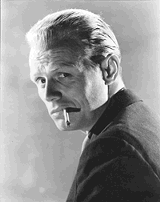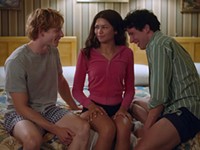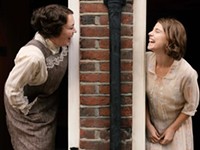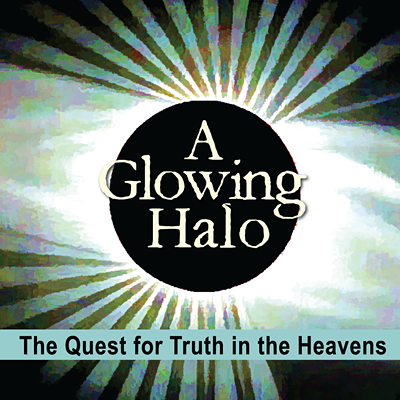[
{
"name": "500x250 Ad",
"insertPoint": "5",
"component": "15667920",
"parentWrapperClass": "",
"requiredCountToDisplay": "1"
}
]
Samuel Fuller's Pickup on South Street opens with a scene that is downright dazzling, even by today's standards. It takes place on a crowded New York City subway. As people shift about, a man and woman eventually end up face to face.
They begin to make goo-goo eyes at each other, but the flirtation is merely a distraction for the man to lift the woman's wallet as he expertly times the stopping of the subway with the closing of her purse. Two other subway riders witness the crime and give futile chase; the woman departs, eventually realizing that she's been had.
That brief scene, which doesn't take more than four or five minutes, is enough to suck viewers into this 1953 classic. The man is Skip McCoy (Richard Widmark), a seemingly fearless petty thief who has just completed his third prison stint. He takes his plunder back to his home, a dilapidated bait-and-tackle shack on the river (complete with gangplank entrance), and is shocked to discover that the wallet contains a strip of microfilm.
Skip's subway mark was Candy (Jean Peters), a perky woman who was supposed to deliver the film to a contact of her extremely nervous (and extremely abusive) boyfriend Joey (Richard Kiley). What she doesn't know is that Joey is a dirty Commie bastard and that the film contained "a patent for a new chemical formula," which, best I can tell, is secret code for "something that will help the Ruskies win the Cold War." When Candy tells Joey the film has been swiped, he demands she recover it immediately.
Meanwhile, the local police (tipped off by the two feds who witnessed the pick pocketing) start hounding Skip, who suddenly realizes he might have stumbled upon something very valuable. His beliefs are confirmed when he returns to his shack one night to find it being ransacked by an intruder. The darkness prevents him from seeing the prowler is Candy, so Skip goes in swinging, knocks her out cold with a fierce blow to the jaw, and revives her by emptying a bottle of beer on her head. And that's before they start making out. (Foreplay just ain't what it used to be, kids.)
The rest of the fairly succinct film follows Skip, Candy, the fuzz, Joey and his Commie pals as they jockey for possession of the valuable strip of film. Most of the movie's characters turn to a lowlife stoolie (an unforgettable Thelma Ritter) for what amounts to the exact same information. Ritter's performance is the glue that holds Pickup together, and she was rightfully nominated for a Best Supporting Actress award that year (she lost to From Here to Eternity's Donna Reed; Ritter went 0-for-6 in that category between 1951 and 1963).
Equally impressive is Fuller's direction, which only slips when he portrays Joey as a perpetually sweaty nudnik. (If they were always that soggy, the Reds would have been really easy to finger, and potential Commies would include Richard Nixon and David Dinkins).
His camera placement is impeccable, most notably in the scene near the end that is shot through the bars of Candy's headboard, making Skip look like he's back in the clink. Listen for the barely noticeable alarm when Candy discovers her wallet is missing, and see if you can count the number of times Fuller's script (based on a Dwight Taylor story) makes reference to Candy's line of work.
Pickup will screen this Saturday night at the Dryden Theatre following an introduction by the 87-year-old Widmark, who will accept the title of George Eastman Honorary Scholar, discuss his career, and stick around and answer your questions after the film, too. (Widmark, whose Oscar-nominated turn in 1947's Kiss of Death is playing at the Dryden on Friday night, is Pickup's only living cast member.)
Tickets for Saturday's special event are $10 ($8 for members and students) and can be purchased at the Museum's admission desk. For more information, call 271-3361.
The Next Big Thing also features a NYC subway pickpocket, only this time there aren't any FBI agents or Cold War maguffins to be found. Instead, we meet a resourceful grifter named Deech Scumble (Jamie Harris, Dinner Rush) who is conning fares by telling people he's collecting money to buy sandwiches for the homeless.
When he drops his Styrofoam cooler, which is supposed to be full of tuna, bologna and PB&J, the riders are shocked to see their wallets and other valuable personal effects spilling out onto the floor of the train.
Meanwhile, one of Scumble's marks, a man named Gus Bishop (Chris Eigeman, a regular in Whit Stillman films), hustles to make a meeting with an influential art gallery owner (Farley Granger). Gus is a struggling artist who has been rejected by every other Manhattan gallery, and this attempt to have his work exhibited elicits the same results. To make matters worse, Gus returns home to find his apartment has been burgled. Then his girlfriend (Marin Hinkle) dumps him because the rest of her friends are married and buying homes in the Hamptons.
Though Gus doesn't know it, something exciting is about to happen to his career. When Scumble ransacked his apartment, he took one of Gus's paintings. And when Scumble can't come up with rent money, he gives the painting to his landlord and makes up a heartbreaking story about the troubled artist.
Not only does the landlord bite, he sells it to a dealer, who talks it up to an influential collector, who in turn spends $10,000 on the piece. Each time the painting changes hands, the fictional legend of the artist (Geoffrey Buonardi, to match Gus's initials in the bottom right corner) grows.
Before you know it, Geoffrey Buonardi becomes the toast of the New York art world, leading Scumble to contact Gus, explain the situation, and strike up a unique business arrangement in which he'll become the artist's manager so long as he keeps pumping out paintings and stays completely anonymous (this is funny because Scumble knows nothing about art and thinks Picasso cut his ear off).
In a matter of days, Gus's paintings are fetching millions of dollars.
There are two women after the non-existent Geoffrey Buonardi, too: a desperate art groupie, Florence Rubin (Janet Zarish) and a critic, Kate Crowley (Connie Britton), who, along with every other art snob in the film, gushes over the Gus/Geoffrey pieces, saying ridiculous things like, "He's way past all the post-modern rhetoric."
Even though nobody knows who this artist is, he lands in the spotlight of the important biennial show at the Whitley Museum (filling in for New York's Whitney).
If you haven't figured it out already, Thing is a satire of the art community. Gus can't get anyone to look at his paintings because he's not oppressed or strung out --- he's just a middle-class white guy from New Brunswick, New Jersey. Similar situations have been explored recently in John Waters' much better film, Pecker, and there was even an interesting subplot in last season's Dark Angel.
Sadly, the send-up here is relatively weak. I think the romantic comedy angle might have been better if it were downplayed in favor of more biting satire. Then again, I'm not sure that would have done enough to fill out Thing's skeletal concept.
Interested in raw, unedited movie ramblings from Jon? Visit his site, Planet Sick-Boy www.sick-boy.com, or listen to him on WBER's Friday Morning Show.
Latest in Movie Reviews
More by Jon Popick
-

Good fun in the sun with Shirley
Feb 4, 2004 -

Hollywood’s trying to wink at us
Jan 28, 2004 -

Monster party at the theater
Jan 21, 2004 - More »






